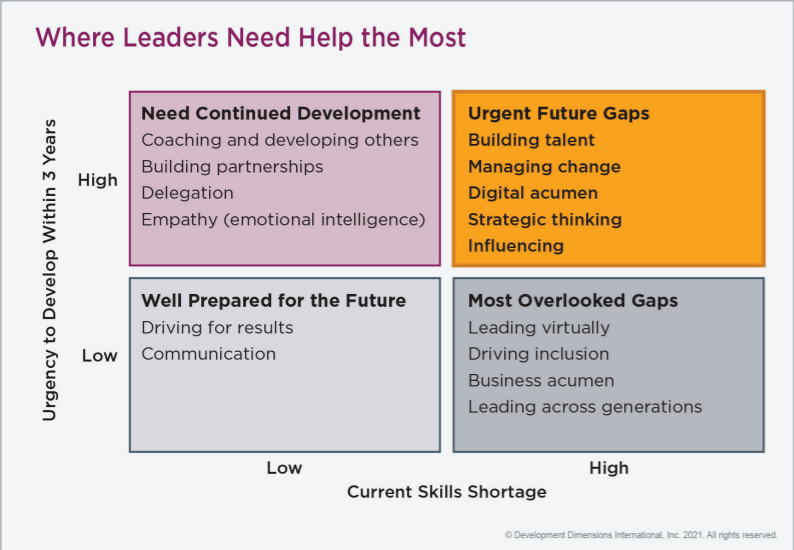$166 billion is spent annually on leadership training in the US alone. And yet, when asked, just 11% of executives said that their leadership training programmes were making an impact. But these failings aren’t inherent to leadership training itself. They’re about how it gets done, and, more importantly, how they define their core skill - leadership.
‘Leadership’ covers so many different traits, abilities, behaviours etc. that the word on its own has very limited use. But, if companies dig into their individual nuances of leadership, choosing the specific types that their organisations and industries demand, leadership training can still have the intended effect. And this is essential right now.
Change is accelerating in every industry and the best way a company can have an effective response is to build a certain type of leadership. It has to be unique to each organisation. But there are certain leadership sub-skills that are suited to combatting the new challenges organisations are facing. By building these through skill-specific leadership training, businesses can build a new set of behaviours to ballast against 2021’s year of ongoing challenges.
1. Emotionally intelligent leadership
Burnout is on the rise. In an Indeed survey, over half (52%) of respondents reported feeling burned out in 2021. The Development Dimensions International’s (DDI) Global Leadership Forecast 2021 found that “the number one factor that influences burnout is leaders’ ability to demonstrate empathy”.
More than ever before, a new tone of leadership is needed, one that understands the heightened difficulties of its workforce. The pandemic changed how businesses and employees interact. Remote working and process tech have increased the distance between managers and employees in terms of workflow. At the same time, an increased emphasis on mental health support, child-care, etc. has made managing a more emotional role. Employees expect managers to be part of their support system, improving their lives, not just their employee experience.
Leadership training that takes this into account is desperately needed. Not just to let managers fill the new roles expected of them, but to change the company culture to become more holistic. Famously, 75% of employees leave their bosses, not their jobs. To duck dive the current turnover tsunami, businesses should develop widespread emotional intelligence initiatives.
2. Educational leadership
The DDI 2021 forecast found that the #1 problem for CEOs was developing the next generation of leaders. The ability to get other people to learn is a developing issue that hasn’t been placed as highly in the leadership skill framework as others. As Filtered CEO Marc Zao Sanders recently explained in Harvard Business Review, how (and whether) an employee learns is one of the most important questions an employer can ask.
With this in mind, a newly essential role of leaders in 2021 is ensuring that people learn - developing their inheritors. The problem is that this is both one of the most important and overlooked skills for leaders in 2021.
However, once leadership training programmes actually include the skills needed to continue and accelerate in-work training, businesses will become more effective. 43% of highly engaged employees receive feedback at least once a week compared to only 18% of those with low engagement. If leaders are upskilled to become teachers as well as managers, culture and performance will respond.
3. Transformational leadership
The chaos of 2020 revealed how possible transformation is. In 2019, McKinsey wrote that “The academic research is really clear that when corporations launch transformations, roughly 70 percent fail.” Since then, most businesses have had to manage previously unthinkable transformations.
In 2021, McKinsey promote a different approach. They want leaders to develop a new skill: thinking 10x bigger. They use the story of a Cincinnati hospital that increased their telehealth visits from 2,000 a year in 2019 to 5,000 a week in 2021. The hospital estimated that, without the pandemic, a transformation like that would have taken years of devoted effort.
In this new landscape, a particular type of leadership training is essential to nurture the type of boldness and certainty that can make these transformations happen. Especially since, currently, only 35% of leaders say that they’re equipped to manage change. Now, businesses need leaders who, as David Lancefield and Christian Rangen put it in HBR, work the edges of the organisation. This means a new type of leader who is bent on constantly thinking about what their organisation can become.
Getting it done in practice
Somewhat counterintuitively, developing leadership skills isn’t the only reason to invest in developing leadership skills. There’s unprecedented focus on upskilling at the moment. This is a rare moment that L&D might have the buy-in and funding to set up a strong leadership development infrastructure.
The DDI 2021 forecast found that there were a certain number of practices that correlated with leadership development success. Organizations that were using at least three of these practices had not only 1.8X higher leadership quality, but also 1.4X higher leadership success rates and 1.5X stronger backup options. These included HR having access to the up-to-date status of leadership development capability throughout the org; HR having an effective process for identifying leadership potential; and the organisation having a clearly defined set of competencies for leadership development.
Just by attempting to set up a leadership programme in the 2021 mould, businesses can set up a developmental framework that’ll far outlast the initiative itself. Companies surveyed in the Global Leadership Forecast report on average, “only 42% of critical roles can be filled rapidly by internal candidates.” With the high possibility of more crises on the horizon, businesses need frameworks in place to make sure that future leaders can be prepared for leadership, not have it thrust on them.


